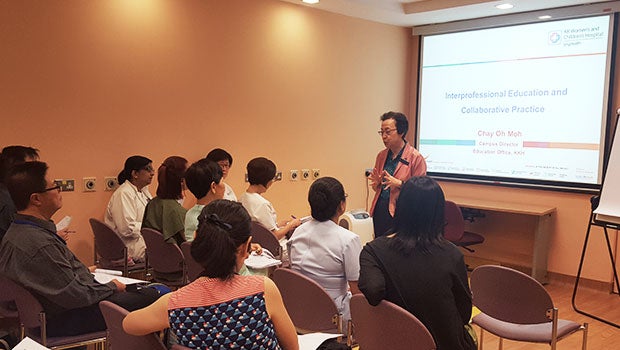
Interprofessional education can save lives, reduce healthcare costs and add value to every encounter between patients and medical professionals, but only when it’s put into practice.

“We thought we had it all along but it’s actually something that’s quite new to us,” Professor Chay Oh Moh professes earnestly.
What Prof Chay, Chair of SingHealth Academy’s College of Clinical Medicine (CCM) is referring to is Interprofessional Education (IPE), the latest buzz phrase in Singapore’s medical landscape, both in schools and in clinical practice.
In the simplest of definitions, IPE is where different healthcare providers come together and “learn with, learn from and learn about each other”, explains Prof Chay whose role at CCM makes her a key driver of interprofessional collaborative practices within SingHealth.
“We used to think it’s IPE when you put a doctor and a nurse in one conference, but it’s not. That’s just each person telling everyone else what they’re doing. There are no discussions about individual strengths and weaknesses and how to build collective competency – things essential to IPE,” she adds.
"There’s no discussion of individual strengths and weaknesses and how to build collective competency – things essential to IPE.”
Turning IPE to IPCP
The heightened push to put IPE into Interprofessional Collaborative Practice (IPCP) is not without cause. As patient care becomes more complex, healthcare professionals across boundaries and disciplines must learn to work not just closely, but collaboratively.
Case in point: Singapore’s ageing population has meant an increased incidence of stroke. Caring for stroke patients involves a large team including the neurologist and emergency physician in the acute phase, followed by therapists and medical social workers thereafter.
In such scenarios, it becomes crucial for the team to work collaboratively. “Our roles may be different but our understanding of the problem should be the same,” says Prof Chay.
She emphasises that real collaboration calls for mutual respect and acknowledgement that doctors sometimes have to take a backseat when others are better suited to lead a situation.
What drove home this point was when a senior nurse in the intensive care unit helped to save the life of Prof Chay’s patient. The medical officer had just reviewed a patient and although charts showed nothing suspect, a senior nurse urged Prof Chay (who was then a Registrar on call) to hurry to the ward. True enough, things took a turn for the worse that evening but the patient survived thanks to their timely intervention.
“I have learned since my days as a junior doctor just how experienced these senior nurses are. They may not make diagnoses but their clinical acuity is very good because they see more patients than we do,” says Prof Chay.
It’s all for the patients
She shares another instance where IPCP benefited the patient: A team at KK Women’s and Children’s Hospital (KKH) needed to transfer a Down syndrome patient to Singapore General Hospital (SGH), so doctors, nurses and pharmacists from both hospitals came together to discuss the case and bring up possible issues during transfers. They also involved the parent of a former patient and the Down Syndrome Association Singapore for feedback and advice.
Through these discussions, the team designed a smoother, less disruptive process. Among many things, measures included a virtual tour of SGH, an accompanied tour of the hospital led by a nurse and a checklist provided by KKH on how to manage Down syndrome patients’ different temperaments and abilities.
Legal matters such as deputyship were also discussed and process explored to facilitate for the continuing care of these vulnerable young people after the transition to the adult setting.
Adding value for prevalent conditions
In addition to rare but serious cases such as Down syndrome, IPE that leads to IPCP is beneficial for common conditions such as childhood asthma which affects one in five children.
KKH is establishing a Common Care Pathway for Childhood Asthma which will derive a standardised care plan for all patients. This will minimise repeated, sometimes inconsistent, information from different parties (nurse, doctor and pharmacist) which may confuse the patient.
“Real collaboration calls for mutual respect and acknowledgement that doctors sometimes have to take a backseat when others are better suited to lead a situation.”
In an ideal scenario, nurses are the ones who teach patients how to use the inhaler and when the doctor comes in, he or she will ask the patient to demonstrate. “I add value by affirming that the patient is using the inhaler correctly. At the same time, this confirms that learning has occurred,” says Prof Chay.
Equally important is the informal IPE that happens in everyday interactions between colleagues. Even for Prof Chay who has over 40 years of medical experience, learning never stops.
“Progress of technology and medicine over the last 10 to 20 years has been so remarkable, so rapid that all of us have a lot to catch up on. Each one, even the younger ones, will bring new knowledge that we can learn from. So really, if you are ready to learn, there are many opportunities around. You just need to open your eyes and ears for it.”













 Get it on Google Play
Get it on Google Play